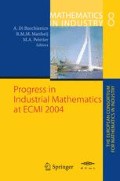Summary
Finite element approximation in space and Crank-Nicolson approximation in time are used to model incompressible creeping flow of molten glass with temperature dependent viscosity. Iso-P triangle elements and second degree approximation of temperature and velocity fields are applied. Localized thermal behavior is captured with adaptively refined unstructured mesh.
Access this chapter
Tax calculation will be finalised at checkout
Purchases are for personal use only
Preview
Unable to display preview. Download preview PDF.
References
C.L. Babcock. Silicate Glass Technology Methods. Wiley, New York, 1977.
J.M.A. Cesar de Sa. Numerical modeling of glass forming processes. Engineering Computations, 3(4):266–275, 1986.
K. Laevsky. Pressing of glass in bottle and jar manufacturing: numerical analysis and computation. PhD thesis, Eindhoven University of Technology, The Netherlands, 2003.
I. Sawai and S. Inoue. Spezifisches gewicht der ternären gläser CaO-Na- 2 O-SiO bei hoher temperatur. Journal of the Society of Chemical Industry of Japan, Transactions, 43(2):47B–49B, 1940.
G. Strang and G.J. Fix. An Analysis of the Finite Element Methods. Prentice-Hall, Englewood Cliffs, N.J., 1973.
A.F. Van Zee and C.L. Babcock. A method for the measurement of thermal diffusivity of molten glass. Journal of American Ceramic Society, 34(8):244–250, 1951.
O.C. Zienkiewicz and R.L. Taylor. The Finite Element Method. Butterworth Heinmann, 5 edition, 2000.
Author information
Authors and Affiliations
Editor information
Editors and Affiliations
Rights and permissions
Copyright information
© 2006 Springer-Verlag Berlin Heidelberg
About this paper
Cite this paper
Kagan, P., Mattheij, R. (2006). Thermal Modeling of Bottle Glass Pressing. In: Di Bucchianico, A., Mattheij, R., Peletier, M. (eds) Progress in Industrial Mathematics at ECMI 2004. Mathematics in Industry, vol 8. Springer, Berlin, Heidelberg. https://doi.org/10.1007/3-540-28073-1_19
Download citation
DOI: https://doi.org/10.1007/3-540-28073-1_19
Publisher Name: Springer, Berlin, Heidelberg
Print ISBN: 978-3-540-28072-9
Online ISBN: 978-3-540-28073-6
eBook Packages: Mathematics and StatisticsMathematics and Statistics (R0)

